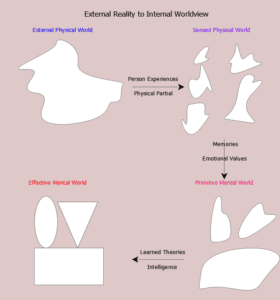Suggested reading order from fundamentals to conclusions.
How We Think with Neurons. A introductory view on the Mental Construction perspective. Specific neurological features of the brain’s neurons shape our thoughts and their associations.
Neural Connections. Regularities in the cortex allow some generalizations. The functions of dendrites and axons in neural signaling. The neural threshold is an All-or-None signaling system that leads to the Almost Gate, a central feature of the brain’s organizing the complexity of daily activities into manageable categories. Repeated experiences give rise to localized maps in the brain for sensory data as well as semantic categories. Neural Cascade and Concept Elevator are important consequences of neural thresholds and genetic neural pathways.
External to Internal. Physical sensation is processed by neural connections from initial experience to internal categories. Our individual genetic endowment immediately constrains the data that comes to our intention as well as how we use that information. Also, we each have partial and personal experiences of external reality which molds our particular handling of information. The nature-nurture combination is augmented by knowledge learned from social, cultural, and academic sources. This knowledge has uncertainty and arbitrariness embedded.
Brain Building. Human minds are built layer-by-layer. Once a layer is established, after its critical period is past, new experiences are categorized and understood in terms of the operative categories and semantic maps. The brain’s physical structure changed to support new behavioral challenges as life evolved from single cell organisms to primates. Our mental apparatus stands upon the previous methods. The adult mind develops after completing numerous learning stages and relies on much knowledge beyond one’s experience. Classical theories of individual development (Maslow, Kohlberg, and Erikson) illustrate how each stage depends on previous stages.
Creativity. An indubitable consequence of our limited knowledge and yet the need to make decisions, creativity bridges the gap between possibility and certainty. It goes by many names: induction, common sense, insight, intuition, best guess, working hypothesis. As we all know, sometimes it leads to erroneous thoughts.
Epitome of thought. High above other cognition biological imperatives, the emotional reactions, and the enhanced sensory and memory facilities of the cortex—in the prefrontal lobes our conscious thoughts retain two distinct threads, association and logic. Thoughts arise in our consciousness by induction and deduction. A blend of inductive beliefs used as logical premises, reasoning can be short-circuited by the need for an immediate decision.
Mental Construction Model. Mental Construction adapts a triune pyramid (biological base, emotional middle, and a cognitive capstone). The capstone is a dual process: half devoted to immediate action, half devoted to future gratification, but they exchange information until a decision is forced. Decision making proceeds on the immediate side by patterns and similarities, while future gratification depends on words and logical deductions.
New Mental Construction posts discuss consequences and implications of the theory.

Great, here’s the book. Bravo! MG